Names and Titles of The Pharaoh in Ancient Egypt
The king/pharaoh in ancient Egypt had five different titles as:
1- Horus name.
2- Nebty name.
3- Golden Horus name.
4- Neswbety name.
5- Sa Re name.
6- Tutankhamun
7- Tuthmosis III
8- Hatshepsut
9- King Mina
10- Ramses II
11- Akhenaten
12- King Khufu
13- King Djoser
14- King Snefru
15- King Khafre
16- Queen Nefertari
17- King Pepi II
18- Cleopatra VII
19- King Seti I
20- Twosret
21- Djedefre
22- Pharaoh Menkaure
23- Pharaoh Unas
24- Mentuhotep II
25- Mentuhotep III
The Horus name
less suitably called banner-name or Ka-name represents the king as the earthly embodiment of the old falcon-god Horus, who became the dynastic god of Egypt, and as such was identified with the sun-god Re, himself also at some very early period the dynastic god. This name is frequently written within a rectangular frame, at the bottom of which is seen a design of recessed paneling such as we find in the facades of early brick tombs and in the false doors of Old Kingdom mastabas; on the top of the rectangular frame perched the falcon of Horus, in more elaborate Dynasty XVIII examples crowned and accompanied by sun and uraeus. It is not quite certain whether the building symbolized by the rectangle and façade (together termed the Serkh) was the King’s palace or his tomb. The former alternative is the more probable, since in the oldest times the Horus name was the commonest designation of the king, and it is unlikely that a purely sepulchral name should have been chosen for the purpose. Still, its associations with the Ka or the (spirit) came to be very close. On the whole, we may conclude that the Horus name denotes the aspect of Horus worn by the king whilst dwelling in the palace.
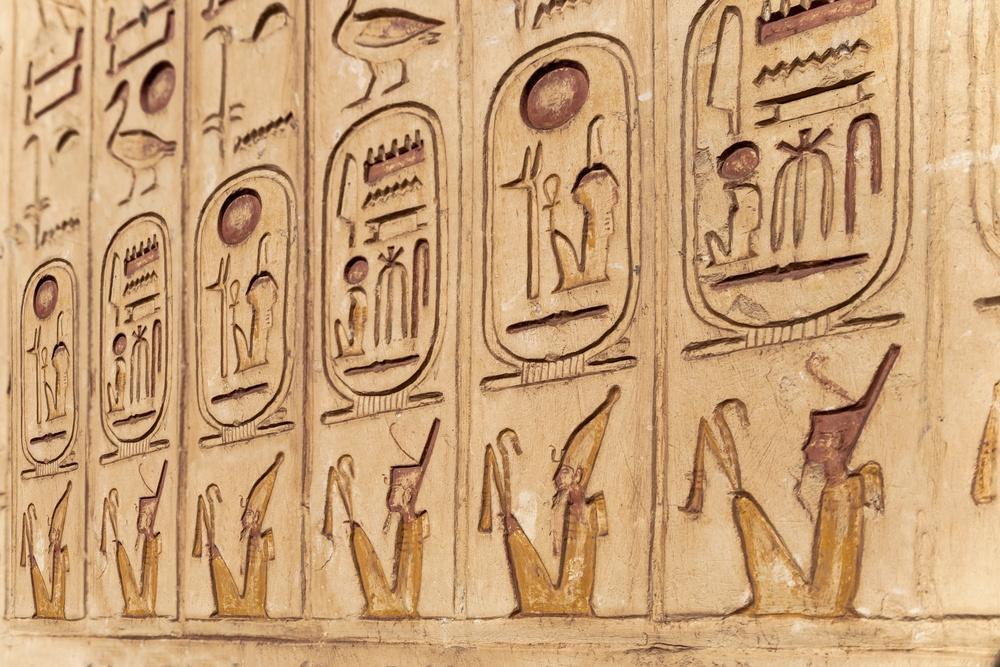
The Nebty name
so called because of the probable reading of the group (vulture and cobra) is Nebty “the two ladies” displays the king as standing in a special relation to the two principal goddesses of the period immediately preceding Dynasty I, when Egypt was still divided into two kingdoms; these were the vulture goddess Nekhebt of the Upper Egyptian city of El Kab and the cobra goddess Wajet of the Lower Egyptian city of Dp, these cities were in the close vicinity of the early capitals of Nekhen or Hieraconpolis and Pe respectively, and it is to this reason that the two goddess owed their prominence. Probably Menes, the founder of Dynasty I, was the first to assume the Nebty title, symbolizing thereby the fact that he had united the two kingdoms.

The Golden Horus name
is more disputed. On the Rosetta Stone, that the monogram (Horus above the gold) symbolized Horus as Victorious over Nebt “the Ombite” i.e the god Seth who was worshipped at Ombos near the modern Qena. This was, no doubt the interpretation of Greek times, but the evidence of the earlier periods points in another direction. The concept of the golden falcon can be definitely traced back to Dynasty XI, and an inscription of Dynasty XII describes the golden Horus name as the “name of gold” (rn-n-nbw).
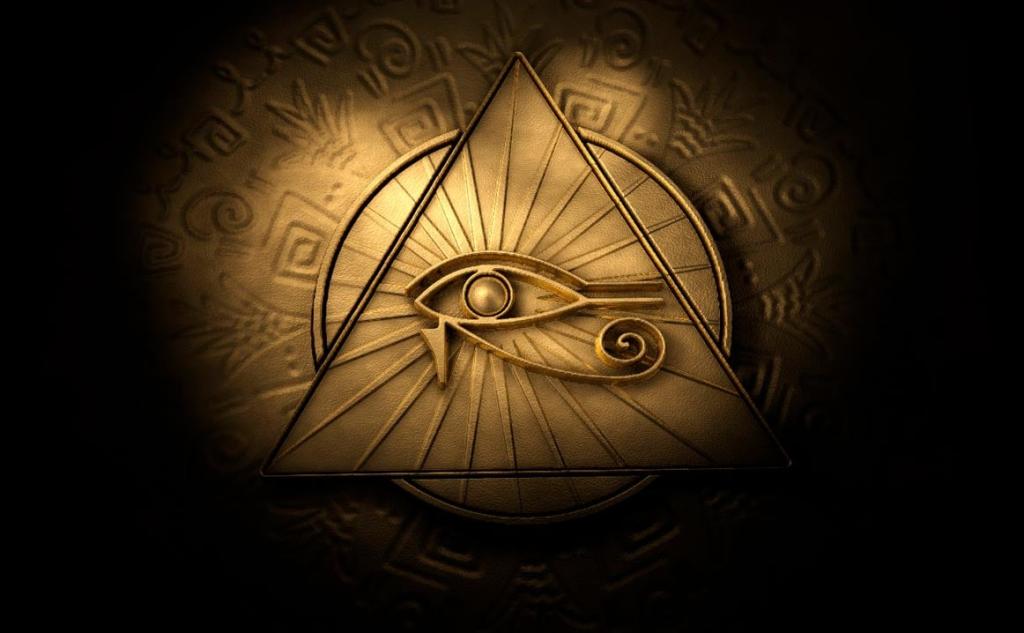
The Neswbity
or Prenomen is the name which follows the title (n-sw-bit) “he who belongs to the sedge and the bee” the plant (swt) symbolizing Upper Egypt is supposed to be identical with the flowering (scripus-reed) or sedge, Egyptian (shemea), a common emblem of Upper Egypt; the exact connection of the bee with Lower Egypt is still obscure. In effect the title means “King of Upper and Lower Egypt”, and the Rosetta Stone translates it. The prenomen itself is almost compounded with the name of the god Re; typical examples are “Shtp-ib-re” (propitiating the heart of Re) (Amenmhat I), “Nb-Maat-Re” (Lord of the truth is Re) (Amenhotep III); one of the first cases of Re as an element in a king’s name is with “Re-kha-f” (Khafre) of Dynasty IV, and the instance without Re all date before Dynasty IX. The prenomen and nomen are invariably written within cartouches (the French word means an ornamented tablet of stone, wood, or metal destined to receive an inscription) or “royal ring”. The cartouche depicts a loop formed by a double thickness of the rope, the ends tied together so as the offer to the spectator the appearance of a straight line; strictly speaking, the loop should be round, as it is one or two very early examples, but becomes elongated and oval because of the length of the most hieroglyphic names enclosed in it: the Egyptians called the cartouche (shenw) from a verb-stem (sheni) “encircle”, and it seems not unlikely that the idea was to represent the king as ruler of all “that which is encircled by the sun”, a frequently expressed notion. Another name of the cartouche not found before Dynasty XIX is (mensh).

The Sa-Re name
or nomen, is introduced by the epithet (sa-Re) “son of the sun-god Re”. The name in the cartouche was, as a ruler, that borne by the king before accession to the throne; it is almost the equivalent of our family name. The first Egyptian kings to distinguish a nomen and a prenomen were those of Dynasty V.
The five names of the titulary have a rigidly fixed order. The principal name is the prenomen, and this is often found alone or accompanied only by the nomen. Only very rarely does the Horus name serves for identification purposes.
To introduce the king’s name the phrase (hem-n) is often found; this we translate “the Majesty of”, but the origin of the expression is obscure. As a speaker the king refers to himself (hem-i) “My Majesty”, he is dressed as (hem-k) “Thy Majesty”.
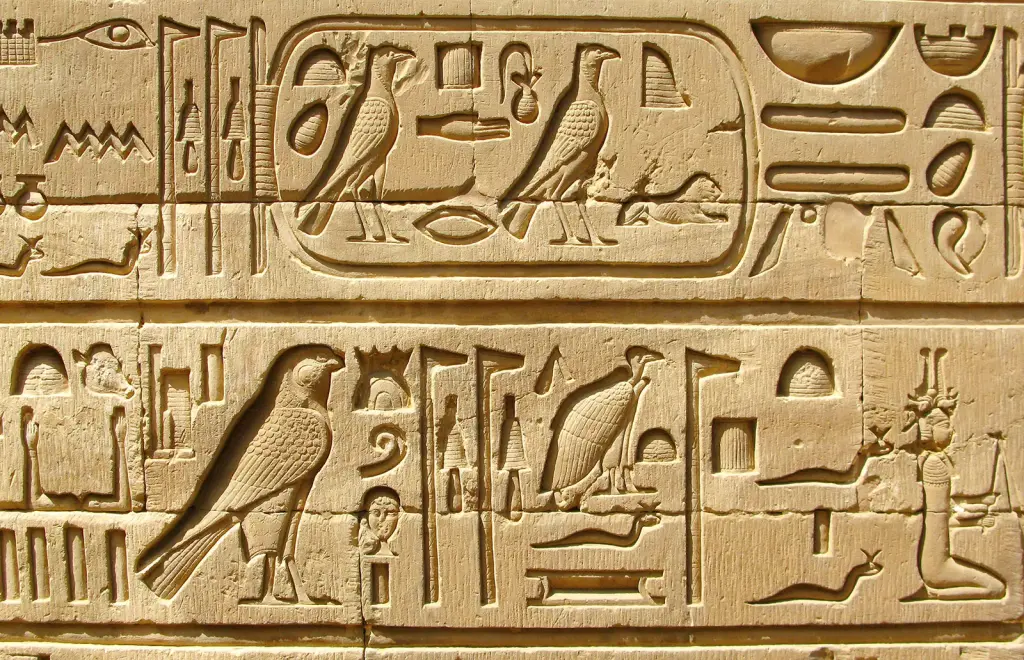
The ordinary word for king is (nsw); for less common is (ity), which we conventionally translate “sovereign”, another fairly common appellation is (nb) “the Lord”.
As regards the term “pharaoh”, the facts are as follows. The Egyptian original (pr-aa) “courtier of the Great House” and clearly there referred to the palace itself or the court, and not to the person of the king. From the end of Dynasty XII onwards the term is written (pr-aa-ankh-weja-snb) “Great House, may it live, prosperous, be in health”, but still it seems to mean only the palace. The earliest certain instance where (pr-aa) refers actually to the king is in a letter to Amenhotep IV (Akhenaton), which is addressed to (pr-aa-ankh-weja-snb-nb) the pharaoh. From Dynasty XIX onward it is used occasionally just as (hem-f) “His Majesty” might be used.
Tutankhamun
the general public refers to the "boy king." He was a young boy who took the throne of Egypt during the 18th Dynasty. He is best known for his nearly intact tomb discovered in 1922 by Howard Carter. There were many treasures in the tomb. His reign helped return Egypt to their traditional religious ways following the reforming by Akhenaten. The golden mask he wore was symbolic of ancient Egyptian art; though he reigned quite briefly, the masked artifact with his face on is still remembered. The discovery of his which was found to contain over 5,000 items, is considered one of the most important archaeological findings to this day.
Tuthmosis III
also called the "Napoleon of Ancient Egypt," was truly one of the greatest military pharaohs of Egypt during the 18th Dynasty. He extended the Egyptian Empire, through his successful military campaigns, from the Euphrates River in the north down to Nubia in the south, he is remembered for his brilliant strategies in his famous victory at the Battle of Megiddo that made Egypt dominant in the region, besides his military successes, Tuthmosis III was a great builder who commissioned several temples and monuments throughout Egypt. In his time, the Egyptian Empire prospered and expanded.
Hatshepsut
one of the most amazing queens in ancient Egyptian history, rose to power as a co-regent with her stepson "Thutmose III" because he was still young when his father "Thutmose II" died. She declared herself pharaoh and ruled Egypt for almost 22 years, her rule was characterized by peace, economic prosperity, and building monuments like the famous temple in Deir el-Bahari. She sponsored trade missions, in particular to the Land of Punt, bringing more wealth and materials into Egypt. However, this effective and powerful ruler, upon her death, had "Thutmose III" try to remove her from history, deleting her name and likenesses from temples and monuments, possibly as a means to retake for himself the sole right of kingship in the eyes of the gods and any future generations.
King Mina
better known as "Narmer", is noted to be the first pharaoh to have united Upper and Lower Egypt and thus began Egypt's dynastic period, about 3150 BC. By initiating the First Dynasty, he provided the beginnings of a unified Egyptian civilization. Credit to his name is the establishment of the city of Memphis which would later be the capital and political center of ancient Egypt. More than a unifier, Mina commissioned significant engineering projects. He ordered the development of several projects, including the shifting of the Nile's course in Lower Egypt to protect Memphis from possible flooding. His reign can be regarded as the turning point in Egyptian history, marking the beginning of a strong and centralized kingdom that would last for three thousand years.
Ramses II
was one of the most powerful pharaohs in Egypt, having reigned from 1279 BC to 1213 BC during the 19th Dynasty. He is remembered for his military genius since, during his time, he commanded an army of 100,000 warriors and successful campaigns that included the famous Battle of Kadesh, his reign also witnessed monumental building projects such as the grand temples of Abu Simbel and the Ramesseum, expressions of his religious devotion to the gods and his memory. Ramses II left such an imprint on Egyptian history that at least nine later pharaohs took his name. The long and successful rule had an indelible mark on Egypt's cultural, political, and military annals; henceforth, he would be referred to as "Ramses the Great."
Akhenaten
ruled from 1353 to 1336 B.C., reigned for 17 years, and is remembered primarily for his religious revolution, he introduced the people to monotheistic worship of Aten, the disk of the sun as their only god, this was a principal turning point within Egypt's polytheistic beliefs and one that had broken a tradition that had been in place for many years. His reign is often referred to as the Amarna Period, during which art and culture were changed. Akhenaten's wife Nefertiti is almost as renowned, and many Egyptologists believe that she played a major role in his reign, even to the extent of being co-regent, Egypt rapidly readopted the worship of its old gods after Akhenaten's death, and most of his religious reforms were undone by successors; thus, his reign constituted a very unique and somewhat controversial chapter in Egyptian history.
King Khufu
he is principally known to have constructed the Great Pyramid of Giza, one of the Seven Wonders of the Ancient World, it was originally 481 feet tall and remained the largest pyramid ever built a marvel of ancient engineering. Khufu's reign, which lasted for at least 24 years, saw the peak of pyramid-building in Egypt's Old Kingdom. Very few relics related to him have been found despite his monumental legacy. The only statue known of Khufu is small, about 9-centimeter-high ivory, which was found in 1903, this statue, which is housed at Cairo's Egyptian Museum, offers a unique window into the life of this mystery king.
King Djoser
is the one who ordered on the throne the Step Pyramid at Saqqara, the first big stone building in Egypt, and a predecessor of later pyramids, his reign has been associated with the great leap in architecture facilitated by his architect Imhotep, who designed the pyramid. Stability and prosperity characterized the rule of Djoser, which allowed the strong administrative and military power of Egypt to develop. This is the Step Pyramid, comprising six superimposed mastabas, which speaks to the true beginning of the great pyramid-building tradition in ancient Egypt. The architectural novelty of the Step Pyramid would forever serve as a testament to the reign of Djoser and would be eternally coupled with him, commemorating a legacy of transformational leadership.
King Snefru
(c. 2613–2589 BC), the founder of the 4th Dynasty, achieved revolutionary improvements in pyramid building. This king is credited for building three major pyramids, a fact that quickly transformed the face of pyramid architecture. The first one, which he built at Meidum, collapsed; the second one he built at Dahshur was called the Bent Pyramid and represented a stage in the transitional phase from step to smooth-sided pyramids, the greatest of Snefru's achievements was the Red Pyramid at Dahshur, the first true smooth-sided pyramid in Egypt. It was to become the model for such later magnificent constructions as the Great Pyramid of Giza. His reign would be remembered as a period of inventiveness, victorious campaigns, and high living standards. He also left behind an architectural legacy to help define Egypt's heyday of pyramid construction.
King Khafre
of Egypt's 4th Dynasty, ruled from around 2558–2532 BC. He is best known for his pyramid, the second largest in Giza, standing directly beside his father Khufu's Great Pyramid, his rule has also been associated with the construction of the most iconic Great Sphinx guarding the Giza Plateau supposed to carry his likeness. Though Khafre's pyramid is a little bit smaller than Khufu's, it seems to be higher because it is built on high ground. His architectural achievements had come to symbolize the mighty power of Egypt and the god-like status of its pharaoh. Khafre's reign was a carry-on from the monumental building projects that characterized the Old Kingdom, and his legacy remains chiseled in stone at Giza, one of the most visited and admired archaeological sites in the world.
Queen Nefertari
wife of Ramses II, is famous for her beauty, intelligence, and the influential role she played during the 19th Dynasty, which has been dated from about 1290–1224 BC. The direct translation of her name is "the most beautiful of them all", her husband considered her an exceptionally valued queen; thus, Ramses II called her his Great Royal Wife. Nefertari was a very important participant in the diplomatic and religious life of that time and was often depicted with the pharaoh on monuments and in temples. Her tomb in the Valley of the Queens is the most beautiful and best-preserved, having vivid wall paintings with minute details that denote her high status and the richness of her times. The beauty of her tomb and her importance in Ancient Egyptian history live on.
King Pepi II
the Pharaoh of the 6th Dynasty of Egypt was considered to have the longest reign in ancient Egyptian history, as his rule extended for 90 years, the very long reign of Pepi II was stable and economically sound, though it was at that time when decentralization was rampant, with the emergence of powerful regional governors known as the nomarchs. Most of Pepi II's reign was marked by extensive building, with additions to his pyramid at Saqqara, his very long reign eventually contributed to the weakening of centralized authority and thus to the decay of the Old Kingdom. One of the longest-reigning monarchs in Egyptian history, Pepi II's long reign is one of the most fascinating chapters in Egyptian history, which shows both the strengths and problems of Ancient Egyptian monarchy.
Cleopatra VII
the last active pharaoh of the Ptolemaic Kingdom of Ancient Egypt, reigned from 51 BC until she died in 30 BC. She was also lauded for her political sagacity and pursued restoration of the former glories of Egypt within the expanding Roman world. Learned in many languages and subjects ranging from mathematics to astronomy, her life and reign were focused on securing the Egyptian throne through major alliances first with Julius Caesar and then with Mark Antony. Her dramatic, tragic end, following her defeat by Octavian future Emperor Augustus-marked the close of the Ptolemaic dynasty and the beginning of Egypt's transition into a Roman province. Cleopatra continues to be a source of fascination and myth, her wit, astute political prowess, and doomed love affairs inspiring countless artistic and literary productions.
King Seti I
was renowned for his military genius and the great building he carried out in Egypt. During his reign, Egyptian authority and order were completely restored to what they had been before the chaotic latter part of the 18th Dynasty. Under Seti I, successful field operations were undertaken to reestablish Egyptian supremacy in the Levant and Nubia. Architecturally, he is known for the grand temple constructions at both Abydos and Karnak, each having exceptionally well-preserved and detailed relief, his tomb in the Valley of the Kings is one of the most sumptuously ornamented, having elaborate wall paintings and inscriptions that form a valuable record of its period in art and religious expressions.
Twosret
was the last female pharaoh of Egypt's 19th Dynasty, reigning from about 1191 to 1189 BC. She was the Great Royal Wife of Seti II and, later, regent for her stepson Siptah. When Siptah finally died, she proclaimed herself pharaoh, one of only a few women to rule Egypt as a reigning monarch. Twosret's reign was characterized by attempts at restoring stability and royal authority. Her rule was plagued with strife and economic difficulties. Immediately following her death, her successor in the 20th Dynasty moved to remove her name from monuments as part of efforts to erase her memory. This notwithstanding, Twosret remains an important figure in Egyptian history since her life has much to do with the transition between dynasties.
Djedefre
also Pharaoh Radjedef ruled under the 4th Dynasty of Egypt from circa 2528-2520 BC. He was a son of Khufu and then took over as king following his father. What he is remembered for mainly is moving the royal necropolis from Giza to a new location at Abu Roash and starting a pyramid there that was then abandoned. His reign is often thought to be transitional, as the great building and construction at Giza came to an end, and there was a shift to more alternative forms of architecture, the pyramid of Djedefre was never completed but stands only as a ruin today, his reign is significant in tracing the developments within the architectural and political environment of Old Kingdom Egypt.
Pharaoh Menkaure
better known as Mykerinos, ruled over Egypt during its 4th Dynasty-from about 2510 to 2460 BC-and is best known for commissioning the third, and the smallest of the three pyramids at Giza. The pyramid of Menkaure is much smaller than its two predecessors constructed by Khufu and Khafre but is nonetheless distinguished by its excellent building quality and its magnificent mortuary temple. His reign is marked by further building and by the extraordinary achievements of art during the period. Among Menkaure's pyramid complex are what many believe to be some of the finest examples of Old Kingdom statuary, which includes the famous statues of Menkaure with his queen and the goddess Hathor. His reign, though shorter and less grandiose than those of his predecessors, set its seal upon the architectural and artistic legacy of Egypt.
Pharaoh Unas
who ruled in the 5th Dynasty of Egypt from about 2356 to 2323 BC, made several contributions toward pyramid construction and religious texts, his pyramid at Saqqara was the last of the Old Kingdom pyramids, and it had a feature that was unique in its architecture: the Pyramid Texts. These were the oldest known religious writings in ancient Egypt, carved onto the walls of his burial chamber to accompany and protect the king on his journey to the afterlife. The reign of Unas, though short, was a phase of growth in the process of change that pyramid building had passed through in relationship with religious rituals of the royal burials, his pyramid and the inscriptions on it are typical of the continued importance of religious beliefs in guarding the pharaoh's journey toward eternity.
Mentuhotep II
who ruled over the 11th Dynasty from about 2055-2004 BC, is highly celebrated because he reunified Egypt after the First Intermediate Period that had left it torn apart in total disunity and civil war. He initiated the Middle Kingdom era of stability and renascence. Mentuhotep II built a great mortuary temple at Deir el-Bahari with a unique terraced structure and introduced some innovative architectural features that would influence the building of temples for the rest of history. His military campaigns, administrative changes, and patronage of the arts helped to firm up his position and reestablish Egypt's central authority, the work carried out by Mentuhotep II paved the way for a successful and culturally flourishing age in Ancient Egypt.
Mentuhotep III
who ruled during the 11th Dynasty (circa 2004–1992 BC), is remembered for his efforts to consolidate and strengthen the Middle Kingdom of Egypt. His reign followed that of his father, Mentuhotep II, who had reunited Egypt after the First Intermediate Period, Mentuhotep III continued this work by stabilizing the kingdom and reinforcing its administration, he is known for his building projects, including a large mortuary temple at Deir el-Bahari, which was later expanded by his successors. Mentuhotep III’s reign was marked by significant administrative and military accomplishments that contributed to the continued prosperity and centralization of the Middle Kingdom. His efforts helped solidify the foundations laid by his father and ensured a stable and prosperous era for Egypt.
In conclusion, a few words must be said concerning how the royal names may be best represented in English. The Horus name, Nebty name, and Golden Horus name ought perhaps to be translated; so far as that is possible, at least, for the epithets employed as names are often very obscure in their meaning. The prenomen and nomen, on the contrary, must be left in their Egyptian forms, for to replace “King Tuthmosis” with “King Thoth-is-born” would be obviously absurd.

how such names should be vocalized?
for only in the rarest cases do we know how an old Egyptian name was really pronounced. The practice followed by a number of historians and writers is to utilize the names given by the historian of Egypt Manetho (first half of the 3rd century BC), so far as the forms handed down by the excerptors of Manetho are fairly recognizable as transcriptions of the hieroglyphic writing. When, however, the Manethonain form is either absent or barely recognizable as an equivalent of the hieroglyphic, a guessed transcription will be found preferable, for example, Horemheb for (Hr-m-hb), where Manetho gives Haramis.



























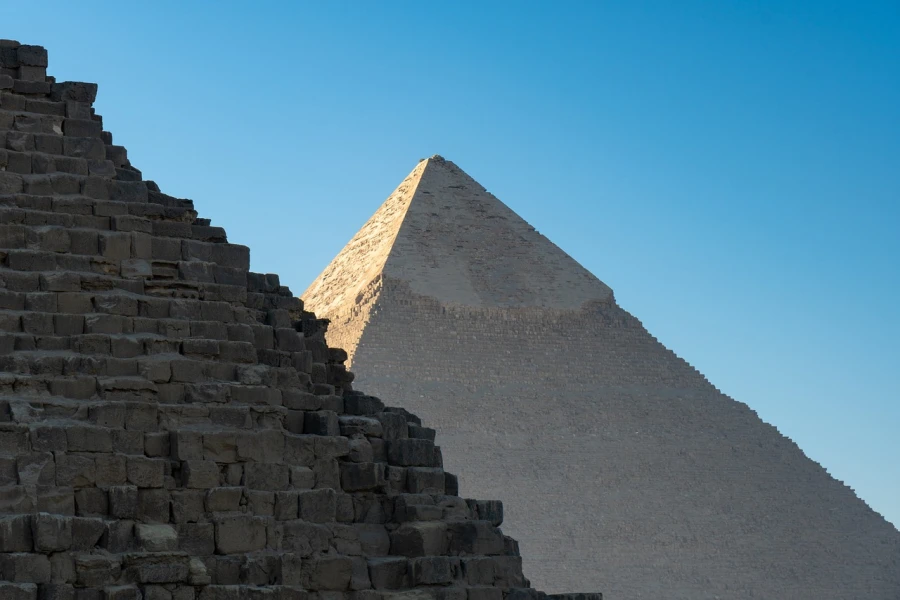



-webp.webp)


-webp.webp)




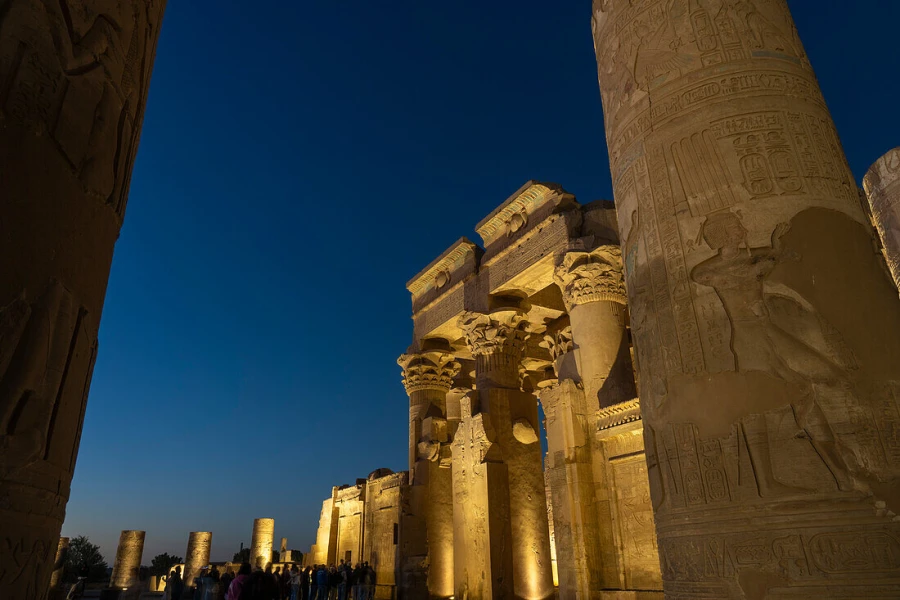


-webp.webp)

















-on-Instagram_-“Another-view-angle-of-the-Golden-mask-of-King-Tutankhamun,-Cairo-museum_-_____________________________________________-FOLLOW-➡️…”-webp.webp)



























-webp.webp)









-webp.webp)

















-webp.webp)
-webp-webp.webp)
-webp-webp.webp)
-webp-webp.webp)
-webp-webp.webp)
-webp-webp.webp)
-webp-webp.webp)
-webp-webp.webp)
-webp-webp.webp)
-webp-webp.webp)
-webp-webp.webp)
-webp.webp)
-webp-webp.webp)
-webp-webp.webp)
-webp.webp)
-webp.webp)
-webp.webp)
-webp-webp.webp)
-webp.webp)
-webp-webp.webp)
-webp.webp)
-webp.webp)
-webp.webp)
-webp.webp)
-webp.webp)
-webp-webp.webp)
-webp-webp.webp)
-webp-webp.webp)
-webp-webp.webp)
-webp-webp.webp)
-webp-webp.webp)
-webp-webp.webp)
-webp.webp)
-webp-webp.webp)
-webp-webp.webp)
-webp-webp.webp)
-webp-webp.webp)
-webp-webp.webp)
-webp-webp.webp)
-webp-webp.webp)
-webp-webp.webp)
-webp-webp.webp)
-webp-webp.webp)
-webp-webp.webp)
-webp-webp.webp)
-webp-webp.webp)
-webp-webp.webp)
-webp.webp)
-webp.webp)
-webp.webp)
-webp.webp)



